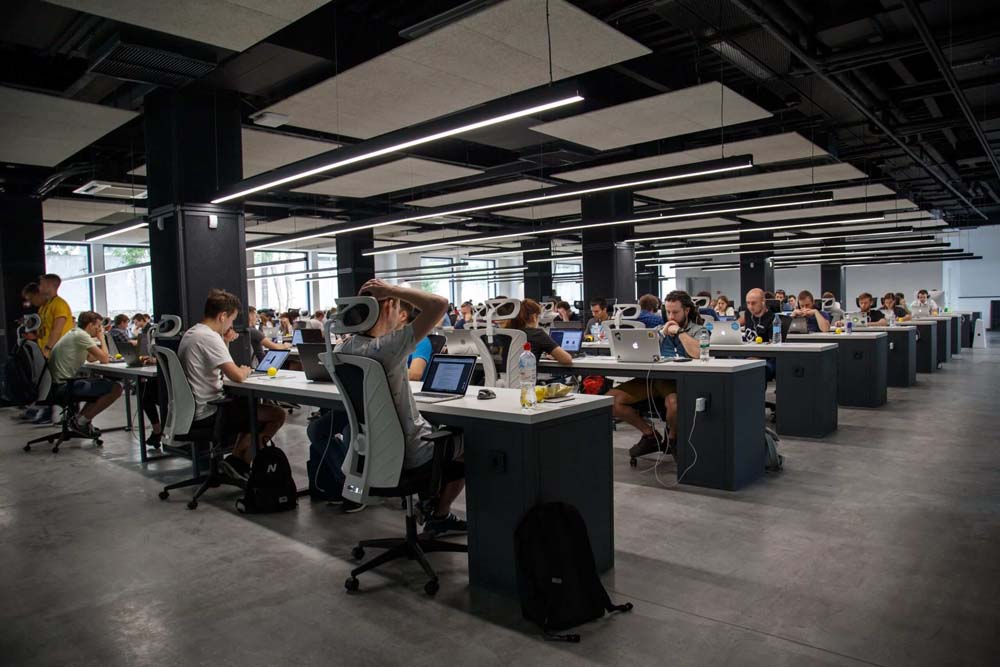Spurred by innovative office technology and expanding globalization, the nature of work has had a massive metamorphosis over the last two centuries. Much like how agrarian economies (an agricultural society) gave way to industrial economies, now our industrial economy has turned into a service-centered economy. Over this period, whole sectors and professions have been changed as well, with some fading away as new ones replaced them. And as sectors and professions are changed or replaced, advancing digital technology is forcing people to rethink workspace design.
According to a report published by Deloitte, a multinational professional services network, “The most recent transformation of the world of work—in response to digitalization—has also brought about tangible change. Over recent decades, the use of digital technologies has risen markedly, and there has been a visible shift in the occupations, roles, and skills involving the use of these technologies.”
Tech-enabled workspaces are increasingly changing the expectations held by employees when it comes to present-day workspace design. For many people, merely the idea of sitting at the same desk in a cubicle for hours on end is quickly becoming antiquated. The workforce of the digital age demands flexible workspace designs because when the world of work evolves, the workplace needs to evolve as well.
Employees Need the Best Available Tools and Technology
As organizations endeavor to enhance workplace productivity, it’s becoming more imperative that employees are furnished with not only the best environment but the best possible tools and technology. Without both of those, worthwhile productivity isn’t going to be at the same level—no matter how marvelous a workplace you design.
While productivity is perhaps one of the first elements people talk about when discussing technology and the workplace, providing an environment that allows employees to work more productively is equally essential. For this reason, when beginning the office design process, it’s crucial to start by identifying their needs—what technologies are required to build a workspace that is as productive as possible?
Furthermore, it’s important to understand that the office design process is notably complicated; it involves much more than merely providing the correct office technology and the space to use it in. One must consider the advantages of adopting new modes of working. Such modes might include agile working which promotes workplace wellbeing and employee happiness; employee happiness leads to improved collaboration and ultimately increased productivity. And all of the above starts with the physical design of the workspace.
Office Tools and Technology Trends In Workspace Design
Data-Tracking Smart Campuses
Many organizations are beginning to look into data-tracking smart campuses. With employees more mobile than ever, it’s becoming vital for organizations to rely on data-tracking applications to collect analytics on the utilization of their space.. Such data will direct organizations to maximize space and energy use. And with commercial property prices steadily rising, this data is invaluable.
The Constantly Changing World of Workplace Technology
Even outside the advanced Smart Campuses, businesses are integrating cutting-edge technology, devices, and tools into their spaces. Everything from top of the line smart devices to video walls have found their way into the world of Workspace Technology. And it doesn’t stop there, every day there are new advancements in consumer and occupational technology that serve, not just to make your life better, but your work too. And for a business committed to the betterment of its employees, that might mean a treadmill of tech shifting in and out of the space as more and more new configurations become available.
Smart Offices Need Smart Floors
Smart technology and the Internet of Things (IoT) is fueling the rise of the smart office. More workplaces are making the move towards ever-increasingly connected workspaces. According to a 2017 study from Business Wire of Berkshire Hathaway, data from more than 8,000 employers found that 35 percent use wearable technology in their wellness program, and that number continues to rise every day.
But many spaces are not properly equipped to handle the power and data needs of these new devices and office technology. In response, solutions like FreeAxez’s Gridd® low profile raised floor system for cable management and GriddPower® have opened up the possibilities of workspaces, by giving them the flexibility and adaptability to account for the never-ending stream of new technology.
Gridd® lets space managers install a low profile raised flooring system that makes cable management easy and efficient. Gridd® doesn’t require any tools for installation or reconfiguration, making changes for cable and power placement quick and easy, without affecting occupational efficiency. Gridd® is an all-steel system made in the USA, meaning that it’s a sustainable option for cable management.
Gridd Power® is FreeAxez’s integrated modular power system, that makes other inefficient forms of power cabling obsolete. GriddPower® has various modular components that allow it to be configured to best meet your needs. It’s also an incredibly energy efficient system, alleviating costs and helping lighten your space’s carbon footprint. And with our app GriddMobile®, you can see information about the power and data cabling underneath the floor right at your fingertips on a smart device.
With a Gridd® low profile raised access floor system, you’re not only managing your cables but you’re future-proofing your workspace.. Unlike raised floors of the past, Gridd® is an access floor, cable management solution that meets today’s most demanding business environments. To learn more about Gridd® technology, contact one of our experts today.

